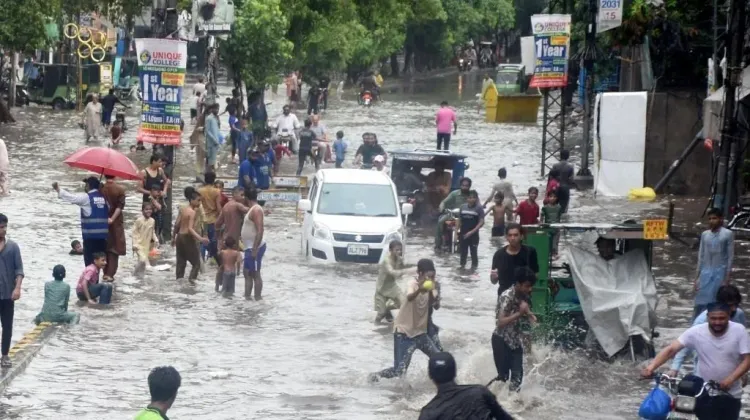How Are Monsoon Rains Affecting Pakistan? 98 Lives Lost

Synopsis
Key Takeaways
- 98 fatalities reported due to flooding.
- 185 injuries linked to rain-related incidents.
- Punjab province faces the highest death toll.
- Emergency alerts issued for further rainfall.
- Urban flooding severely disrupts traffic.
Islamabad, July 11 (NationPress) Severe monsoon rains and subsequent flash floods have tragically resulted in the loss of at least 98 lives and left 185 individuals injured across Pakistan since June 26, as reported by the National Disaster Management Authority (NDMA) on Friday.
The NDMA noted that within the last 24 hours, eight people were killed and 27 others injured due to rain-related incidents.
Punjab province has recorded the highest number of fatalities, totaling 37 deaths, including 20 children, with Khyber Pakhtunkhwa following closely behind with 30 fatalities.
Officials have issued alerts for more rainfall in the days ahead and are advising residents, especially those in low-lying and vulnerable zones, to take necessary precautions. Rescue and relief operations continue in the most affected areas, according to reports from Xinhua news agency.
On July 10, the Pakistan Meteorological Department (PMD) had placed several regions on high alert, including Islamabad, Rawalpindi, Lahore, Sialkot, Gujranwala, and numerous districts in Khyber-Pakhtunkhwa and Balochistan, as the relentless rain continues to batter the nation.
Moreover, multiple roads have been rendered impassable due to flooding, significantly affecting traffic in these cities, as reported by The Express Tribune.
Urban flooding has drastically impacted major cities like Lahore, Faisalabad, and Gujranwala, where rainwater has inundated low-lying areas, causing severe traffic disruptions. Key roads remain submerged, leading to widespread chaos.
The forecast indicates that heavy rainfall is expected to continue through Friday, increasing the risk of flash floods.
In Punjab, cities such as Sialkot, Gujrat, Chiniot, Kasur, Ferozewala, and Sargodha have reported intense rainfall, often accompanied by thunder and lightning.
The Water and Sanitation Agency's (Wasa) Monsoon Control Room reported that Lahore recorded an average rainfall of 58.8mm, with some areas like Nishtar Town experiencing up to 84mm.
As the heavy rains lashed Lahore, deficiencies in the drainage management became apparent, with key areas such as Jail Road, Qurtaba Chowk, and the Wasa Head Office in Gulberg being waterlogged.
Despite claims from the Lahore Waste Management Company (LWMC) about clearing over 6,000 waste containers and deploying cleaning crews, residents expressed frustration over the lack of visible improvement.
The mixture of rainwater and overflowing sewage has raised significant public health concerns, making it increasingly difficult for residents to navigate the clogged roads.
Furthermore, conditions have deteriorated in hilly regions, particularly in Khyber-Pakhtunkhwa and Murree, due to an elevated risk of landslides.
In Balochistan, areas like Zhob and Sibi are among the most severely affected.









